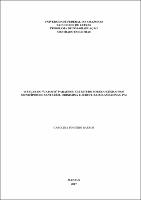| ???jsp.display-item.social.title??? |


|
Please use this identifier to cite or link to this item:
https://tede.ufam.edu.br/handle/tede/5999| ???metadata.dc.type???: | Dissertação |
| Title: | O falar do “caboco” paraense: um estudo sobre o léxico nos municípios de Santarém, Oriximiná e Juruti (Baixo-Amazonas-PA) |
| ???metadata.dc.creator???: | Barros, Carolina Pinheiro  |
| ???metadata.dc.contributor.advisor1???: | Azevedo, Orlando da Silva |
| ???metadata.dc.contributor.referee1???: | Azevedo, Orlando da Silva |
| ???metadata.dc.contributor.referee2???: | Martins, Flávia Santos |
| ???metadata.dc.contributor.referee3???: | Correia, Hydelvidia Cavalcante de Oliveira |
| ???metadata.dc.description.resumo???: | A presente pesquisa é de cunho dialetal e foi realizada na Região do Baixo Amazonas (PA). Seguiu-se os princípios e parâmetros da Dialetologia Pluridimensional aportados em autores como: Cardoso (2005), Correa (1980) e Azevedo (2013). Aborda, principalmente, o nível de variantes lexicais específicas em três municípios, que abrangem a mesorregião do Estado do Pará, a saber: Santarém, Oriximiná e Juruti. Objetivou-se também: mapear áreas linguísticas do Baixo Amazonas, no Estado do Pará, onde ocorrem variações lexicais nos domínios semânticos roça, pesca, pecuária, fauna, flora, mundo biótipo, homem etc.; caracterizar a fala dos moradores de Santarém, Oriximiná e Juruti pela apropriação de léxicos específicos em cada município; comparar os resultados da pesquisa segundo os parâmetros da pesquisa dialetológica na vertente diatópica, diastrática, diageracional, diassexual se apresentarem dados, respectivamente, produtivos; identificar a Norma de Uso nos municípios alvos da pesquisa pela distribuição regular e maior frequência no espaço cartográfico. Os entrevistados foram oito em cada ponto de inquérito, obedecendo às dimensões gênero, escolaridade e faixa etária. Os informantes se dividiram em duas faixas etárias, de 18 a 30 anos, e de 50 a 65 anos de idade, sendo quatro homens e quatro mulheres. Com a obtenção das respostas coletadas in loco por meio de um Questionário Semântico-Lexical, (QSL), contendo 164 questões, elaborado de acordo com os aspectos linguísticos das regiões, elaborei 50 cartas semântico-lexicais sobre as variantes lexicais mais produtivas na região do Baixo Amazonas, PA, caracterizando as normas de uso pela distribuição regular e alta frequência (CRISTIANINI, 2006), Pottier (1978) e Preti (1982). Os resultados mostram que existe para cada domínio semântico uma norma de uso padrão específica. |
| Abstract: | The present research has a dialectal nature and was carried out in the Lower Amazon Region (PA). It followed the principles and parameters of Pluridimensional Dialecology supported by authors such as: Cardoso (2005), Correa (1980) e Azevedo (2013). It mainly addresses the level of specific lexical variants in three municipalities, which covers the mesoregion of the state of Pará, named Santarém, Oriximiná and Juruti. The objective of this study was: a) to map linguistic areas of the Lower Amazon, in this state, where there are possibly lexical variations in the semantic domains of farm, fishery, livestock, fauna, flora, world, biotype, man, etc. b) to characterize the residents of Santarém, Oriximiná and Juruti for the appropriation of specific lexicons in each municipality; c) to compare the results of the research according to the parameters of the dialectical research in the diatopic, diastrátic, diagenerational, and diassexual aspects, if they present data, respectively, productive; d) Identify the standard usage in the municipalities targeted by the survey for the regular distribution and higher frequency in the cartographic space. Respondents were eight in point of inquiry, obeying all the necessary dimensions for gender, education and age. Informants were divided into two age groups - 18 to 30 years and 50 to 65 years, and were also divided into male and female. With the acquisition of the answers collected in loco, carried out by means of a lexical questionnaire (QSL), containing 164 questions, elaborated according to the linguistic aspects of the regions, they were transformed into lexical letters, in order to collect the quantitative data of the lexical variants of the region, the norms of use and frequency, as contributed in their thesis Cristianini (2006), Pottier (1978) and Preti (1982). The results showed that there exists for each semantic domain a specific standard usage, which is represented in 50 semantic-lexical letters. |
| Keywords: | Dialetologia Geolinguística pluridimensional Variação lexical |
| ???metadata.dc.subject.cnpq???: | LINGUISTICA, LETRAS E ARTES |
| Language: | por |
| ???metadata.dc.publisher.country???: | Brasil |
| Publisher: | Universidade Federal do Amazonas |
| ???metadata.dc.publisher.initials???: | UFAM |
| ???metadata.dc.publisher.department???: | Faculdade de Letras |
| ???metadata.dc.publisher.program???: | Programa de Pós-graduação em Letras |
| Citation: | BARROS, Carolina Pinheiro. O falar do “caboco” paraense: um estudo sobre o léxico nos municípios de Santarém, Oriximiná e Juruti (Baixo-Amazonas-PA). 2017. 213 f. Dissertação (Mestrado em Letras) - Universidade Federal do Amazonas, Manaus, 2017. |
| ???metadata.dc.rights???: | Acesso Aberto |
| ???metadata.dc.rights.uri???: | http://creativecommons.org/licenses/by-nc-nd/4.0/ |
| URI: | http://tede.ufam.edu.br/handle/tede/5999 |
| Issue Date: | 8-Jun-2017 |
| Appears in Collections: | Mestrado em Letras |
Files in This Item:
| File | Description | Size | Format | |
|---|---|---|---|---|
| Dissertação - Carolina Barros.pdf | 4.64 MB | Adobe PDF |  Download/Open Preview |
This item is licensed under a Creative Commons License





